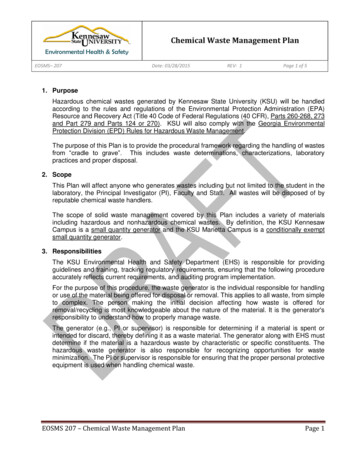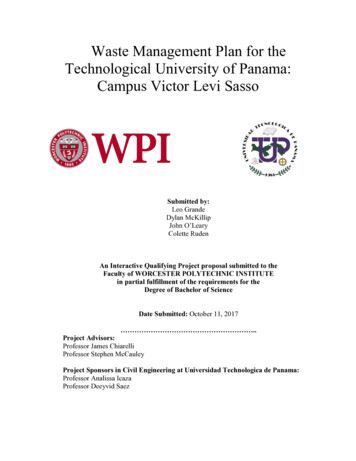
Transcription
Chemical Waste Management PlanEnvironmental Health & SafetyEOSMS– 207Date: 03/28/2015REV: 1Page 1 of 51. PurposeHazardous chemical wastes generated by Kennesaw State University (KSU) will be handledaccording to the rules and regulations of the Environmental Protection Administration (EPA)Resource and Recovery Act (Title 40 Code of Federal Regulations (40 CFR), Parts 260-268, 273and Part 279 and Parts 124 or 270). KSU will also comply with the Georgia EnvironmentalProtection Division (EPD) Rules for Hazardous Waste Management.The purpose of this Plan is to provide the procedural framework regarding the handling of wastesfrom “cradle to grave”. This includes waste determinations, characterizations, laboratorypractices and proper disposal.2. ScopeThis Plan will affect anyone who generates wastes including but not limited to the student in thelaboratory, the Principal Investigator (PI), Faculty and Staff. All wastes will be disposed of byreputable chemical waste handlers.The scope of solid waste management covered by this Plan includes a variety of materialsincluding hazardous and nonhazardous chemical wastes. By definition, the KSU KennesawCampus is a small quantity generator and the KSU Marietta Campus is a conditionally exemptsmall quantity generator.3. ResponsibilitiesThe KSU Environmental Health and Safety Department (EHS) is responsible for providingguidelines and training, tracking regulatory requirements, ensuring that the following procedureaccurately reflects current requirements, and auditing program implementation.For the purpose of this procedure, the waste generator is the individual responsible for handlingor use of the material being offered for disposal or removal. This applies to all waste, from simpleto complex. The person making the initial decision affecting how waste is offered forremoval/recycling is most knowledgeable about the nature of the material. It is the generator'sresponsibility to understand how to properly manage waste.The generator (e.g., PI or supervisor) is responsible for determining if a material is spent orintended for discard, thereby defining it as a waste material. The generator along with EHS mustdetermine if the material is a hazardous waste by characteristic or specific constituents. Thehazardous waste generator is also responsible for recognizing opportunities for wasteminimization. The PI or supervisor is responsible for ensuring that the proper personal protectiveequipment is used when handling chemical waste.EOSMS 207 – Chemical Waste Management PlanPage 1
Chemical Waste Management ProgramEnvironmental Health & SafetyEOSMS– 207Date: 03/28/2015REV: 1Page 2 of 54. DefinitionsConditionally exempt small quantity generator means a facility that generates less than 100 kg(220 lbs) and less than 1 kg (2.2 lbs) of acutely hazardous waste per calendar month (P-listedwaste).Generator is any person whose act or process produces waste. At KSU, and for the purpose ofthis document, this would be the PI, Laboratory Supervisor, Manager or other personresponsible for a local area in which chemicals are used or stored. "Generator" will also be usedfor matters pertaining to the University as a whole.Hazardous waste is any solid waste that is ignitable, corrosive, reactive, or toxic, a listedhazardous material, or contains a listed hazardous material.0 CFRNon-regulated Chemical Waste is any solid waste that is technically not a "hazardous waste",but may pose a significant hazard to human health or the environment, or is unacceptable atlocal solid waste management facilities. Sanitary (municipal) landfills cannot accept liquids orcontained gaseous wastes. Wastewater treatment plants must operate within specific limits fortheir sludge's and treated effluent.Recovered materials means those materials which have known recycling potential, can befeasibly recycled, and have been diverted or removed from the solid waste stream for sale, use,or reuse by separation, collection, or processing.Recyclable material means those materials which are capable of being recycled and whichwould otherwise be processed or disposed of as solid waste.Resource recovery means the process of obtaining material or energy resources from discardedsolid waste which no longer has any useful life in its present form and preparing the solid forrecycling.Small Quantity Hazardous Waste Generator means a facility that generates more than 100 kg(220 lbs) but less than 1000 kg (2200 lbs) of hazardous waste and less than 1 kg (2.2 lbs) ofacutely hazardous waste per calendar month (P-listed waste).Solid waste means any hazardous or nonhazardous garbage, refuse or sludge from a wastetreatment plant, water supply treatment plant or air pollution control facility, domestic sewage andsludge's generated by the treatment thereof in sanitary sewage collection, treatment and disposalsystems, and other material that is either discarded or is being accumulated, stored or treatedprior to being discarded, or has served its original intended use and is generally discarded,including solid, liquid, semisolid or contained gaseous material resulting from industrial,institutional, commercial and agricultural operations, and from community activities. Solid wastedoes not include recovered materials; solid or dissolved materials in domestic sewage; solid ordissolved materials in irrigation return flows or industrial discharges that are point sources subjectEOSMS: 207 – Chemical Waste Management PlanPage 2
Chemical Waste Management ProgramEnvironmental Health & SafetyEOSMS– 207Date: 03/28/2015REV: 1Page 3 of 5to permit under 33 U.S.C. Section 1342; or source, special nuclear, or by product material asdefined by the federal Atomic Energy Act of 1954, as amended (68 Stat. 923).5. Waste Handling ProcedureA.Minimize waste generationBefore beginning a project, it is the responsibility of the waste generator to minimize waste bydetermining the hazards associated with the chemical/product and choosing the chemical/productof lesser hazard. PIs and Supervisors should order and store minimum amounts of chemicals andproducts. Be aware that certain chemicals are difficult and costly to dispose of. Some examplesfollow:B.1)Heavy metals such as mercury, barium, cadmium, chromium, beryllium, silver,selenium, and tellurium.2)Chlorophenols, dioxins, and cyanides.3)Compressed gases including lecture bottles or containers with liquids underpressure. Arrange with the supplier to return empty or unused containers.4)Manufacturer’s samples. Either arrange for the manufacturer to accept return ofunused products or provide an MSDS or product data sheet with a description ofthe product and its characteristics.Satellite accumulation areasSatellite accumulation areas may be established at or near the point of generation of the wastewhere up to 55 gallons of hazardous waste or 1 quart of acutely hazardous waste can be stored.If the stored wastes exceed these limits, the waste must be moved to a 180-day storage areawithin 3 days. This area must be one in which spills can be contained. Secondary containmentshall be employed that will ensure that incompatible wastes are not to mix in the event of a leakor spill. A sink or an open area outside is not acceptable as an accumulation area. Refer to theEPA Hazardous Waste Compatibility Chart for storage requirements.C.Labeling containersWaste containers must be labeled with the words “hazardous waste” or “non-hazardous waste”and the contents of the waste container. A log sheet beside the container is the recommendedway of tracking what is placed in the waste container. EHS along with the chemical wastecontractor will characterize the waste based on the contents. If containers are too small to holda label, they should be placed in secondary containment and that should be labeled.D.Waste containersWaste containers must be compatible with the waste contained in them. Only compatible wastesshall be placed in the same containers. The waste containers must be closed unless waste isbeing placed in the container. Funnels with positive latch lids are available for purchase andshould be used when necessary. Waste that is found in damaged containers must be transferredto intact containers immediately upon discovery.E.Waste pick-up procedureEOSMS: 207 – Chemical Waste Management PlanPage 3
Chemical Waste Management ProgramEnvironmental Health & SafetyEOSMS– 207Date: 03/28/2015REV: 1Page 4 of 5Once the container is full, a waste card shall be created in Chematix and the waste submitted forpick-up by EHS. The start accumulation date is the date when the container is full, not the datewhen the first waste is placed in the container. Chematix will be used for disposing of mixturesof waste materials from lab experiments as well as disposing of pure chemicals that are expiredor no longer needed. Specific training for using the Chematix software is conducted on a routinebasis. Procedures for creating specific types of waste cards can be found on the EHS website.F.Elementary neutralizationThis is the only time a chemical waste is allowed to be placed in the sanitary sewer. If a liquidwaste that is generated in a laboratory carries a corrosive waste code and is hazardous onlybecause of its’ pH, the generator may adjust the pH of the waste to a pH between 6 to 9 and draindispose of the waste. The generator is not required to perform this procedure and EHS willdispose of the waste in that case.G.Aerosol cansAerosol containers will be managed according to the KSU Aerosol Disposal Guidelines. Noaerosol container shall be disposed of in the trash. Even containers that are empty must bepunctured by EHS before placing them in the trash. Any liquid that is released in the process willbe treated as hazardous waste.H.Spill procedureAll areas that generate waste shall have access to spill clean-up materials as described in theKSU Chemical Spill Procedures. Personnel who have been trained to clean-up a spill and havethe proper personal protective equipment to do so may clean proceed with a clean-up procedure.Chemicals or wastes that are unknown or too large to be handled by lab personnel shall bemanaged by EHS either directly or by a contractor.I.Empty containersContainers of hazardous waste will be considered empty according to 40 CFR 261.7. If thecontainer is less than or equal to 119 gallons, then it will be empty when no more than 2.5 cm (1inch) of residue remains on the bottle or inner liner or no more than 3% by weight of the totalcapacity of the container remains in the container or inner liner. If the container is more than 119gallons in size, then no more than 0.3% by weight of the total capacity of the container is left inthe container. The exceptions to this rule are waste gases and containers that contained acutehazardous waste (P-listed waste). A waste gas will be considered empty when the containerapproaches atmospheric pressure. A P-listed waste container is considered empty when thecontainer or liner has been triple rinsed with a solvent capable of dissolving the waste or someother method of cleaning that has been scientifically proven to remove the waste. The rinsate inthis case is P-listed waste. Containers that are empty according to these instructions can beplaced in the garbage after the label has been removed or defaced.J.Chemical inventoryPIs and Supervisors will review their chemical inventories twice a year and dispose of out-datedand unnecessary chemicals. Special attention should be given to peroxide formers and otherEOSMS: 207 – Chemical Waste Management PlanPage 4
Chemical Waste Management ProgramEnvironmental Health & SafetyEOSMS– 207Date: 03/28/2015REV: 1Page 5 of 5potentially explosive chemicals, e.g., ether, tetrahydrofuran, dioxanes, picric acid, etc. Thesechemicals should not be kept past the manufacturers’ expiration date without checking for theformation of dangerous chemical reactions.K.Controlled waste storage unitsEHS will maintain controlled waste accumulation storage units as necessary. The KennesawCampus unit will be a 180-day storage unit. It will be managed according to 40 CRF 261.34(d).The waste will be held for no more than 180 days and no more than 6000 kg (unless the wastetreatment facility is greater than 200 miles in which case there is a 270 day storage limit). TheMarietta Campus unit will be managed so that the total accumulation is less than 1000 kg ofwaste.L.TrainingKSU requires employees who generate chemical waste to be trained annually in basic hazardouswaste management. The Department of Transportation requires that all persons involved in thetransport of DOT-regulated materials must be trained in hazardous materials regulationsaccording to 49 CFR 172 Subpart H. Initial training must be conducted within 90 days ofemployment or change of job responsibilities that cause affect to hazardous materialtransportation and at least every 3 years thereafter. EHS will provide this training either in aclassroom setting or online.6. Plan ReviewThis Plan will be reviewed and updated as necessary but at least annually. The Notification ofRegulated Waste Activity (EPA Form 8700-12) must be reviewed annually and dues paid asrequired by the State of Georgia. This Plan and three years of documentation will be available inthe EHS Office for review by any authorized Agency.EOSMS: 207 – Chemical Waste Management PlanPage 5
Environmental Health & Safety Chemical Waste Management Program EOSMS- 207 Date: 03/28/2015 REV: 1 Page 2 of 5 EOSMS: 207 - Chemical Waste Management Plan Page 2 4. Definitions Conditionally exempt small quantity generator means a facility that generates less than 100 kg (220 lbs) and less than 1 kg (2.2 lbs) of acutely hazardous waste per calendar month (P-listed










